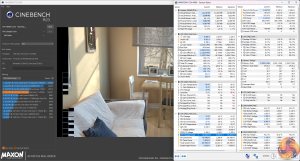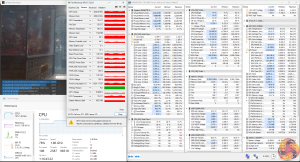CPU-only loading
Looking first at the different power modes from a CPU-only loading perspective, all modes peak at the ludicrously high 115W Turbo Mode for a short period of time.
Gamer stabilises at 55W sustained, which is around 2.7GHz average for mid-60s temperatures.
Creator and Turbo stabilise at 70W sustained, which is around 3.1GHz. Creator runs mid-70s, but Turbo is lower – at high-60s – due to much faster fans.
Creator is the best mode for CPU-only loading, because it runs 70W sustained but without the ludicrous fan noise of Turbo.
GPU-only loading
For GPU-only loading, we use 3DMark Time Spy Stress test.
Gamer and Turbo modes allocate 150W of sustained power to the graphics subsystem, albeit by bouncing above and below the 150W level. This results in clocks of around 2.1-2.2GHz typically.
We see mid-to-high 80s for the GPU and 96C for the memory running Gamer mode. Turbo mode runs faster fans and reduces temperatures to mid-70s GPU and 90C memory.
Creator mode allocates 115W of sustained board power. This results in clock speeds of around 1800MHz typical, with temperatures of around mid-70s for the GPU and 92C for the memory.
Albeit, this is with far more tolerable fan speeds and noise than both Gamer and Turbo.
Gamer is the best GPU-only mode, thanks to its heavy power allocation and reasonable fan speeds.
CPU+GPU loading
And then looking at combined full CPU+GPU maximum loading, we see some interesting results.
Gamer mode uses Nvidia Dynamic Boost in Gigabyte’s Control Center. This results in around 170W combined CPU+GPU power, of which we often see around 135W-ish tends to go for the GPU, with 35W-ish for the CPU. Of course, this will be workload dependent, and it bounces a lot too; sometimes the CPU is up at 70W Turbo and sometimes it is down at 30W.
That is 250W wall power through the charger, by the way
Turbo Mode by default also uses Nvidia Dynamic Boost and operates the exact same way as Gamer Mode. Albeit with very slightly higher boost clocks by virtue of faster fans and fractionally lower temperatures.
Creator Mode, however, runs Gigabyte AI GPU Boost by default. This allows the GPU to stay at 115W sustained, while the CPU maintains its 70W. That is 185W combined – which is around 15W higher than the Gamer and default Turbo Modes, and it resulted in around 265-270W sustained wall power draw.
We noticed that Turbo Mode had the drop-down option for Gigabyte AI GPU Boost. Running this allocates 125W sustained to the GPU and 70W stable to the CPU, albeit with the CPU spiking up at the 110W level initially, which was 320W wall power draw!
So, Turbo Mode with Gigabyte AI GPU Boost looks to be the maximum, all-out mode. But the default Turbo and Gamer modes using Nvidia Dynamic Boost are arguably better for GPU-priority workloads such as gaming; they steal a big chunk of power budget from the CPU and allocate a small amount extra to the GPU.
The Aorus 17H laptop handling 170-195W combined is an impressive result from the cooling system, even if the corresponding fan noise is high.
 KitGuru KitGuru.net – Tech News | Hardware News | Hardware Reviews | IOS | Mobile | Gaming | Graphics Cards
KitGuru KitGuru.net – Tech News | Hardware News | Hardware Reviews | IOS | Mobile | Gaming | Graphics Cards









